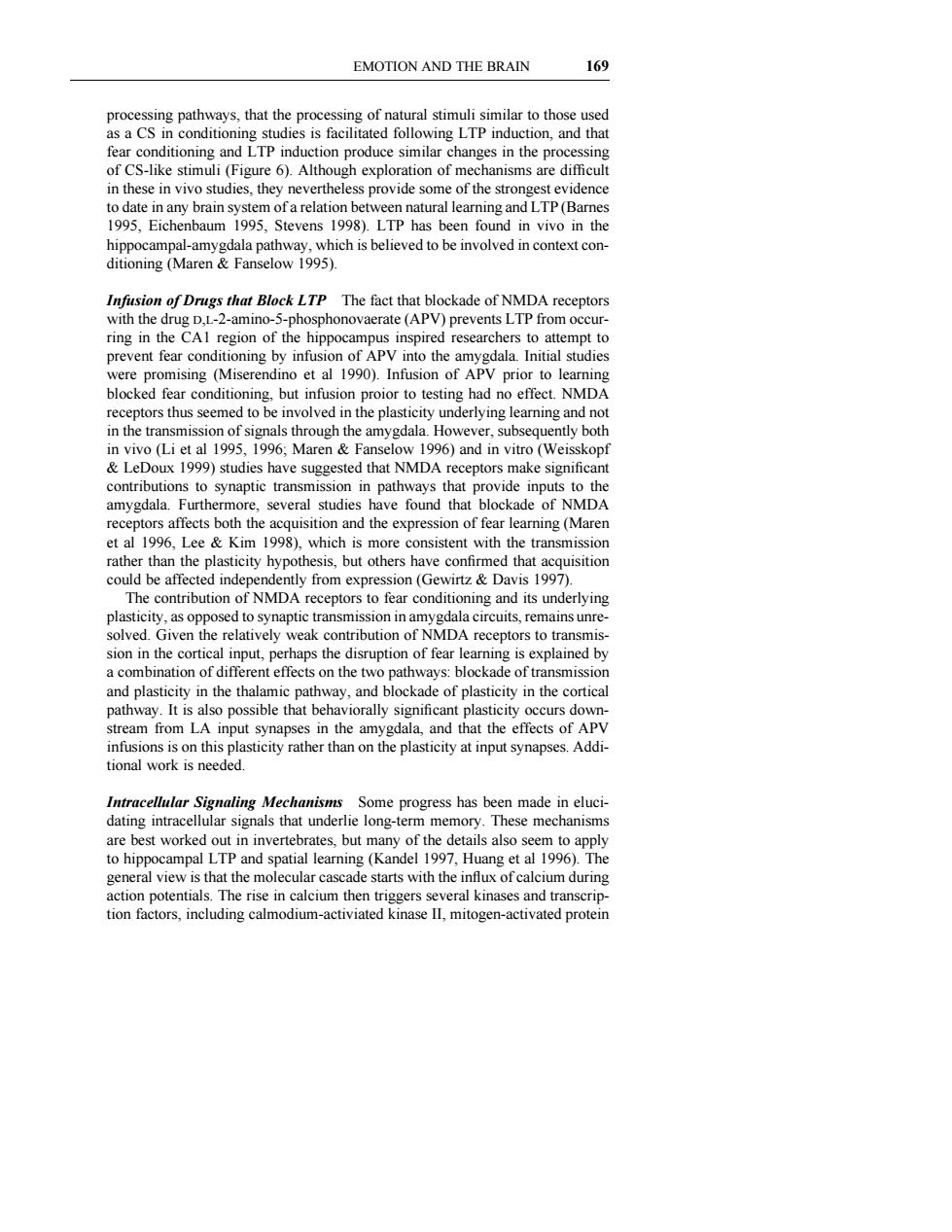正在加载图片...

EMOTION AND THE BRAIN 169 processing pathways,that the processing of natural stimuli similar to those used as a C in cond d following LTP indu and tha of CS-like stimu(Figure 6).Although exploration of mechanisms are difcu in these in vivo studies.they nevertheless provide some of the strongest evidence oning(Mare195) which is (APV)P ringin the CAl region of the hippocampus inspired researchers to attempt to end and not in the transmission of signals through the amygdala.However,subsequently both u9 Mhren s Fansco tha ns to e sig th receptors affects both the acquisition and the expression of fear learning(Maren et al 1996 Lee Kir n 1998).which could be affected inden (G Davi 1997) The contribution of NMDA receptors to fear conditioning and its underlying ven th a combination of different the two pathways blockade of transmission and plasticity in the thalamic pathway,and blockade of plasticity in the cortical pathway.It salso possible that be plas city occurs ses Addi tional work is needed. aling als that Some progre ess has h are best worked out in invertebrates.but many of the details also seem to apply to hippocampal LTP and spatial learning(Kandel 1997,Huang et al 1996).The general view is that the molecular cascade starts with the x of cal mduring EMOTION AND THE BRAIN 169 processing pathways, that the processing of natural stimuli similar to those used as a CS in conditioning studies is facilitated following LTP induction, and that fear conditioning and LTP induction produce similar changes in the processing of CS-like stimuli (Figure 6). Although exploration of mechanisms are difficult in these in vivo studies, they nevertheless provide some of the strongest evidence to date in any brain system of a relation between natural learning and LTP (Barnes 1995, Eichenbaum 1995, Stevens 1998). LTP has been found in vivo in the hippocampal-amygdala pathway, which is believed to be involved in context conditioning (Maren & Fanselow 1995). Infusion of Drugs that Block LTP The fact that blockade of NMDA receptors with the drug D,L-2-amino-5-phosphonovaerate (APV) prevents LTP from occurring in the CA1 region of the hippocampus inspired researchers to attempt to prevent fear conditioning by infusion of APV into the amygdala. Initial studies were promising (Miserendino et al 1990). Infusion of APV prior to learning blocked fear conditioning, but infusion proior to testing had no effect. NMDA receptors thus seemed to be involved in the plasticity underlying learning and not in the transmission of signals through the amygdala. However, subsequently both in vivo (Li et al 1995, 1996; Maren & Fanselow 1996) and in vitro (Weisskopf & LeDoux 1999) studies have suggested that NMDA receptors make significant contributions to synaptic transmission in pathways that provide inputs to the amygdala. Furthermore, several studies have found that blockade of NMDA receptors affects both the acquisition and the expression of fear learning (Maren et al 1996, Lee & Kim 1998), which is more consistent with the transmission rather than the plasticity hypothesis, but others have confirmed that acquisition could be affected independently from expression (Gewirtz & Davis 1997). The contribution of NMDA receptors to fear conditioning and its underlying plasticity, as opposed to synaptic transmission in amygdala circuits, remains unresolved. Given the relatively weak contribution of NMDA receptors to transmission in the cortical input, perhaps the disruption of fear learning is explained by a combination of different effects on the two pathways: blockade of transmission and plasticity in the thalamic pathway, and blockade of plasticity in the cortical pathway. It is also possible that behaviorally significant plasticity occurs downstream from LA input synapses in the amygdala, and that the effects of APV infusions is on this plasticity rather than on the plasticity at input synapses. Additional work is needed. Intracellular Signaling Mechanisms Some progress has been made in elucidating intracellular signals that underlie long-term memory. These mechanisms are best worked out in invertebrates, but many of the details also seem to apply to hippocampal LTP and spatial learning (Kandel 1997, Huang et al 1996). The general view is that the molecular cascade starts with the influx of calcium during action potentials. The rise in calcium then triggers several kinases and transcription factors, including calmodium-activiated kinase II, mitogen-activated protein